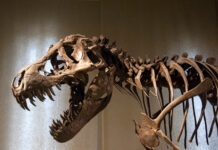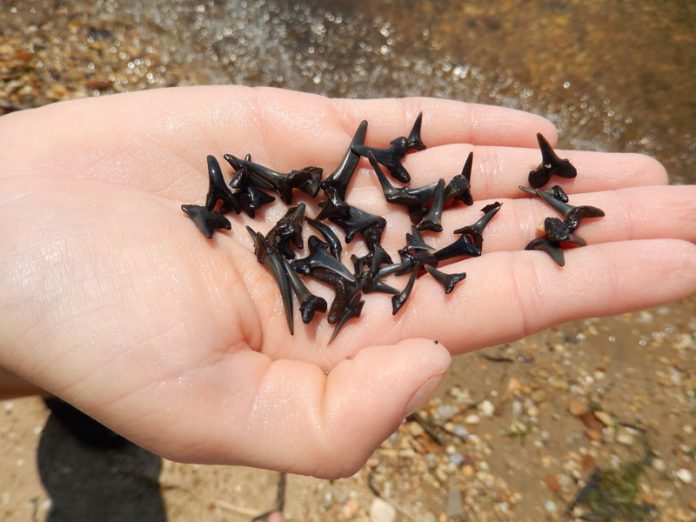
Fossil shark teeth and turritella fossils are easily found at Purse Beach on the western side of Maryland along the Potomac River. The Purse area is the former Purse State Park, which has been absorbed into the Nanjemoy Wildlife Management Area (WMA) which consists of several parcels of land along the east side of the Potomac River and along State Route 224 in southwestern Charles County. The Nanjemoy WMA is open to the public, and recreational activities include bird watching, fishing, and hunting as well as collecting fossils on the beach.
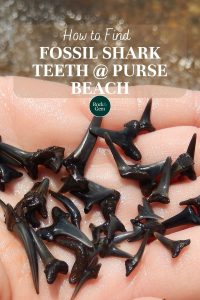
Shark Teeth Fossilization
Fossilized shark teeth are one of the few easily recognizable parts of a shark that fossilizes. The internal skeleton of sharks is cartilage and disappears soon after burial in sediments. The main exceptions are the teeth and dermal ossicles, which are the tiny hard sandpaper-like protrusions on shark skin. The central vertebrate can also become calcified and is occasionally fossilized. Cartilage does not mineralize like bones and breaks down much quicker than the hard parts of a shark. Teeth are the most common shark fossil, but sometimes the fossilized dermal ossicles and pieces of vertebrate are found in the same sediments. The dermal ossicles are tiny and are not as easy to identify as the shark teeth.
Permineralization
Shark teeth become fossils through permineralization. Permineralization can happen with other organisms including crab fossils on Florida beaches. This results when minerals dissolved in water fill the open spaces of an organism or organic tissue, and eventually, only the minerals remain. When a shark loses a tooth or a shark dies, the teeth and the shark sink to the bottom and may be covered by sediments. Teeth or sharks that are not buried, such as those that settle on a rocky bottom or in fast-moving water, will disintegrate. The buried sediment provides an anaerobic, or oxygen-deficient, environment and this preserves the tooth or other hard parts of the shark.
Over time the sediment accumulates and the pressure from the sediments pushes water with dissolved minerals into the tooth. Eventually, the minerals crystallize, and the tooth is nearly entirely replaced by silica and other elements including phosphorous, iron and calcium. The buried sediments are later subjected to tectonic forces and eroded, which exposes the sediments with the shark teeth and other fossils. This mineralization requires lots of time. Fossil shark teeth generally range in age from 75 million to 10 thousand years, and the best way to determine the age of a shark tooth is to know the age of the geologic formation that hosted the fossil. The permineralization process also turns the fossil shark teeth black or dark gray, which makes them much easier to spot in sands along the beach.
The Fossil-Rich Aquia Formation
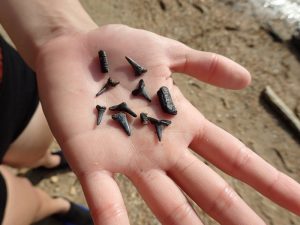 Shark teeth and other fossils at the Purse area are found in the Aquia Formation. The Aquia Formation is composed of clayey, silty, glauconitic sands and has some areas that are rich in invertebrate fossils. The Aquia Formation was deposited during the Paleocene Epoch, which was approximately 59 to 55.5 million years ago. The Aquia Formation is much older than the sediments at Calvert Cliffs on the eastern Maryland shore along the Chesapeake, which is another shark tooth collecting region in Maryland. The Calvert Cliff fossils are within the Chesapeake Group, and were deposited during Miocene Epoch, which was 23 to 5 million years ago. The fossils along the Calvert Cliffs are much younger than those of the Purse area.
Shark teeth and other fossils at the Purse area are found in the Aquia Formation. The Aquia Formation is composed of clayey, silty, glauconitic sands and has some areas that are rich in invertebrate fossils. The Aquia Formation was deposited during the Paleocene Epoch, which was approximately 59 to 55.5 million years ago. The Aquia Formation is much older than the sediments at Calvert Cliffs on the eastern Maryland shore along the Chesapeake, which is another shark tooth collecting region in Maryland. The Calvert Cliff fossils are within the Chesapeake Group, and were deposited during Miocene Epoch, which was 23 to 5 million years ago. The fossils along the Calvert Cliffs are much younger than those of the Purse area.
In southwestern Maryland, the Aquia Formation is best exposed in cliffs along the Potomac and along streams that have cut into the formation. The cliffs along the Potomac are unstable and are constantly eroded. This exposes more sections with shark teeth and other Paleocene fossils.
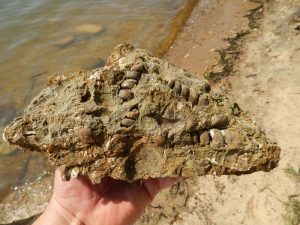
Purse Area Beaches
The Purse area is remote but the roads to get to the site are all paved. The area is reached by taking State Route 224, also known as Riverside Road, which bisects the Nanjemoy WMA. The trailhead parking area is clearly marked with a sign that says it is part of the Nanjemoy WMA. While parking at the trailhead is limited, it is possible to park on the sides of the road south of the park. Parking is limited in these areas, and collectors may have to walk up to one-quarter of a mile to get to the trailhead on busy days.
The trail from the parking area to the beach is flat and well-defined, and collectors will not get lost if they continue to walk westward to the beach. Since the area is relatively remote, there are no nearby restrooms or places to eat. Visitors should bring lunch and plenty of drinking water. It is important to come prepared, as anyone that leaves will quickly lose their parking space and miss out on time spent on the beach.
Purse Beach Advantages
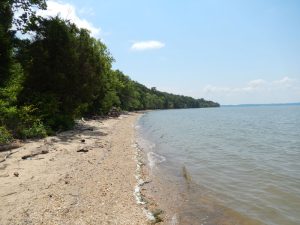
The Purse area beach is narrow, and it is tough to find a good space to sit for lunch or relax when not collecting if the beach is crowded. It becomes much narrower during high tide. Like most beaches, it gets the most use on weekends, but people can show up during the work week.
Purse Beach has another big advantage for fossil collectors and other visitors. The beach faces west, so it has sun until it gets dark. This is a big contrast to the beaches at the Calvert Cliffs on the eastern side of Maryland, which face to the east. The sun quickly goes below the cliffs by late afternoon, and the collecting sites in eastern Maryland become cold and much darker, which makes it more difficult to find shark teeth.
Finding Shark Teeth
Shark teeth, as well as fossil dental plates of rays, are found directly on the surface of the sand and gravel along the beach and along the water line. Some collectors use a small shovel or trowel to dig into the beach gravel and then use a screen to examine the sand and gravel for shark teeth. A metal colander or similar screen can be used for screening, but it is important to have the holes sized correctly. If the holes are too big, some of the smaller teeth will pass through the holes, and if they are too small, they will not screen the sand. Generally, holes should be at least one-quarter inch in diameter. Some collectors also make their own screens with wire screen and wood from their local hardware store.
Walking along the beach and scanning the water line for shark teeth and other fossils is productive for many collectors. Low tide is best for collecting, and it is easy to find the tide tables online. The beach is continuously washing and reworking the sand, and shark teeth and other fossils can be easily spotted on the surface. Shark teeth and ray plates are black and are easy to see in the brown sand and gravel. The sharply pointed shape of a black shark tooth also stands out against the sand and gravel. The ray dental plates have a rectangular shape and are also black.
Tiny Teeth
Many of the shark teeth and ray plates along Purse Beach are tiny and sometimes less than one-quarter inch. Larger teeth are found with the smaller teeth, so any area with teeth may also reveal larger teeth. The largest teeth range up to about one inch long. The teeth at Purse are generally pointy and curved, in contrast to some of the large triangle-shaped teeth found at other shark teeth localities. Many of the teeth found in the Purse area are extremely narrow with sharp points, and these are reportedly from Scapanorhynchus, which is an extinct genus of shark that is like the living goblin shark.
Walking on the beach is safest with shoes. There is potential for broken glass, but the biggest threats to bare feet are small pieces of sharp pointed driftwood. The beach near the trail that leads from the road is generally open and easy to hike. If carrying a phone or camera it is better to stay on land, as some of the water is more than waist deep, and there is always the potential to slip or trip in the water.
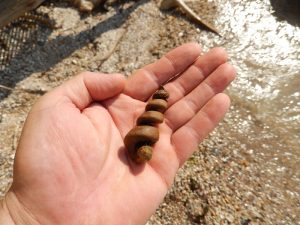
Turritella Fossils – A Bonus
Small cliffs are present north of the trail where it reaches the beach. Fossils are abundant in the rocks exposed in this area, and many of these are turritella, which are tightly coiled sea snails that are shaped like a narrow cone. Most of the fossils are weathered and crumble when touched, but some of their casts are intact. Some of the interiors of the turritella are preserved by fine mud that has filled their interior spaces. The mud solidified and remained intact long after the original shells had eroded. These casts are like a negative of the original animal’s shell.
Turritella is a genus of medium-sized sea snails. They have coiled shells that resemble an elongated cone. The name comes from the Latin “turritus” which means turreted or towered. The Latin diminutive suffix “-ella” means small. Turritella fossils are worldwide and range in age from the Cretaceous to recent periods. Turritella agate is a beautiful specimen and lapidary material.
Where to Find Turritella Fossils
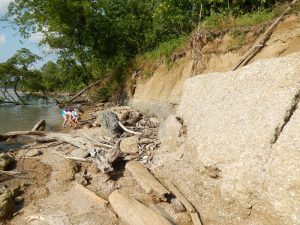 South of the trail along the beach is a small point on the Potomac River. This is just south of a swampy area that drains into the river. The cliffs become steeper south of the swampy area and many trees have fallen and block the beach path. Sections of the cliffs have collapsed and are on shore. This area is difficult to access and will require climbing over fallen trees and wading into the water.
South of the trail along the beach is a small point on the Potomac River. This is just south of a swampy area that drains into the river. The cliffs become steeper south of the swampy area and many trees have fallen and block the beach path. Sections of the cliffs have collapsed and are on shore. This area is difficult to access and will require climbing over fallen trees and wading into the water.
This area has huge outcrops of the Aquia Formation, and in some sections, the entire rock is made of fossils. The fossils are easy to see as they are generally white against the brown-to-black background of the sandy shale matrix. The outcrops have turritella and bivalve fossils, and many of them are solid and are found as loose pieces next to the outcrops and the large boulders. The large blocks that have fallen from the cliffs are often loaded with fossils, and the matrix material is relatively soft. Digging in the cliffs is illegal, as this leads to increased erosion and is dangerous in areas with overhangs. Many of these fossils are turritella casts, and large rocks with distinct turritella casts are found in this area. While shark teeth are certainly present along the beach near the cliffs, the shoreline is so rocky that it is difficult to find teeth in this area.
Getting to Purse and GPS Coordinates
Purse is reached by taking State Route 224, which roughly follows the Potomac River shoreline in southwestern Charles County. State Route 224 is also known as Riverside Road. The parking area is marked with a sign that says “Nanjemoy Wildlife Management Area.”
The following are key GPS coordinates obtained from Google Earth:
• Parking area at trailhead: 38°25’56.33”N, 77°15’6.28”W
• Beach area at end of trail: 38°25’54.69”N, 77°15’23.34”W
• Southern outcrops with turritella fossils: 38°25’24.81”N, 77°15’40.00”W
The Purse area is accessible throughout the year, depending on the weather. Snow and ice are potential issues during the winter, and thunderstorms are a safety hazard, especially during periods of unsettled weather in the spring and summer. Families and advanced collectors will find that the Purse area offers the opportunity to collect both shark teeth and turritella fossils.
This story about fossil shark teeth previously appeared in Rock & Gem magazine. Click here to subscribe. Story & Photos by Robert Beard.




